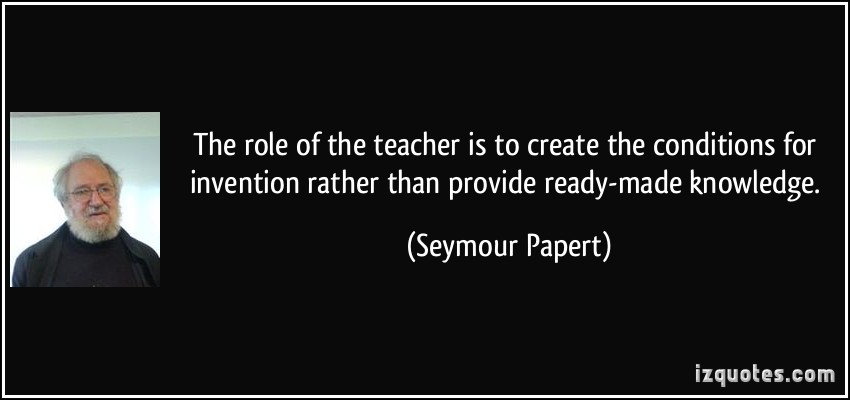Constructionism
Overview
Constructionism is a Philosophy of Education. The belief is that learning is more effective when people are active learners while creating tangible objects in the real world. Learning is reconstruction rather than transmission of knowledge. Learners explore and discover while being guided by constructivist ideas. Learners construct mental models while also constructing a meaningful project.
Constructionism is a Philosophy of Education. The belief is that learning is more effective when people are active learners while creating tangible objects in the real world. Learning is reconstruction rather than transmission of knowledge. Learners explore and discover while being guided by constructivist ideas. Learners construct mental models while also constructing a meaningful project.
Origins & Major Contributors
Seymour Papert, who worked with Jean Piaget, wanted to discover the factors which caused "hidden" learning. While he agrees with much of Jean Piaget’s developmental psychology work, he took it a step further to include the idea of Constructionism. Seymour Papert has been in the center of several movements in education: child development, artificial intelligence, and computational technologies. He believes children are “active agents” in their learning. He believes that learning happens best when “the learner is consciously engaged in constructing a public entity.” He and his team at MIT created the Logo programming language so that children would be active learners, rather than just participating in drill and practice computer programs. So that children could see a tangible result for their computing efforts, he created the Logo Turtle, which was a physical turtle, and later became a virtual turtle which could be manipulated on screen by using the simple Logo programming language. From 1981 until present, MIT’s Epistemology and Learning Group, which Papert founded, has created many advanced technologies for learners including: robotics, system dynamics, multi-agent modeling, and digital fabrication. Papert was the first researcher and educator who designed digital tools for children which assist in interaction.
Implications for Instructional Design
Constructionism follows the same ideas as Constructivism, except a major component is that while students are being active learners, they also are constructing some tangible object which can be shared and discussed with others. The construction of this object is an important component for learners.
When using the ideas of contructionism, any instructional theory can be used to create the instructional design, however, the main concern must be the creation of a tangible item which the learner can share and explain with other members of a learning community.
Constructionism vs. Constructivism
"Constructionism--the N word as opposed to the V word--shares constructivism's connotation of learning as "Building knowledge structures" irrespective of the circumstances of the learning. It then adds the idea that this happens especially felicitous in a context where the learner is consciously engaged in constructing a public entity, whether it's a sand castle on the beach or a theory of the universe." --Situating Constructionism, 2002
Important Seminal Works
Papert, S. (1993a).Mindstorms: Children, computers and powerful ideas. New York: Basic Books. E-BOOK
Papert, S. (1993b).The Children's Machine: Rethinking School in the Age of the Computer. New York: Basic Books. PDF
Papert, S., & Harel, I. (1991). Situating constructionism. In S. Papert & I. Harel (Eds.),Constructionism. New York: Ablex Publishing. PDF
Web Resources
www.papert.org/
Blikstein, P. (2014). Seymour papert’s legacy: Thinking about learning, and learning about thinking.
InTransformative Learning Technologies Lab. Retrieved from https://tltl.stanford.edu/content/seymour-
papert-s-legacy-thinking-about-learning-and-learning-about-thinking
Edutopia staff. (2014). Seymour papert: Project-based learning. In Udutopia. Retrieved from
http://www.edutopia.org/seymour-papert-project-based-learning
Hartsook, J. (Designer). (2014, Feb 21). Constructionism [Prezi Presentation]. Retrieved from http://prezi.com/iqesludajdzs/?utm_campaign=share&utm_medium=copy
Seymour papert. In (2014). Wikipedia. Retrieved from http://en.wikipedia.org/wiki/Seymour_Papert
References
Blikstein, P. (2014). Seymour papert’s legacy: Thinking about learning, and learning about thinking.
InTransformative Learning Technologies Lab. Retrieved from https://tltl.stanford.edu/content/seymour-
papert-s-legacy-thinking-about-learning-and-learning-about-thinking
Cavallo, D., Papert, S., & Stager, G. (2004). Climbing to understanding: Lessons from an experimental
learning environment for adjudicated youth. International Conference on Learning Sciences
(pp. 113-120). Santa Monica, California.
Papert, S. (1993a).Mindstorms: Children, computers and powerful ideas. New York: Basic Books.
Papert, S. (1993b).The Children's Machine: Rethinking School in the Age of the Computer. New York:Basic Books.
Papert, S., & Harel, I. (1991). Situating constructionism. In S. Papert & I. Harel (Eds.),Constructionism. New York: Ablex Publishing.
Wilensky, U. (1991). Abstract meditations on the concrete and concrete implications for mathematics
education. In Constructionism. Norwood, N.J.: Ablex Publishing Corp.
Seymour Papert, who worked with Jean Piaget, wanted to discover the factors which caused "hidden" learning. While he agrees with much of Jean Piaget’s developmental psychology work, he took it a step further to include the idea of Constructionism. Seymour Papert has been in the center of several movements in education: child development, artificial intelligence, and computational technologies. He believes children are “active agents” in their learning. He believes that learning happens best when “the learner is consciously engaged in constructing a public entity.” He and his team at MIT created the Logo programming language so that children would be active learners, rather than just participating in drill and practice computer programs. So that children could see a tangible result for their computing efforts, he created the Logo Turtle, which was a physical turtle, and later became a virtual turtle which could be manipulated on screen by using the simple Logo programming language. From 1981 until present, MIT’s Epistemology and Learning Group, which Papert founded, has created many advanced technologies for learners including: robotics, system dynamics, multi-agent modeling, and digital fabrication. Papert was the first researcher and educator who designed digital tools for children which assist in interaction.
Implications for Instructional Design
Constructionism follows the same ideas as Constructivism, except a major component is that while students are being active learners, they also are constructing some tangible object which can be shared and discussed with others. The construction of this object is an important component for learners.
When using the ideas of contructionism, any instructional theory can be used to create the instructional design, however, the main concern must be the creation of a tangible item which the learner can share and explain with other members of a learning community.
Constructionism vs. Constructivism
"Constructionism--the N word as opposed to the V word--shares constructivism's connotation of learning as "Building knowledge structures" irrespective of the circumstances of the learning. It then adds the idea that this happens especially felicitous in a context where the learner is consciously engaged in constructing a public entity, whether it's a sand castle on the beach or a theory of the universe." --Situating Constructionism, 2002
Important Seminal Works
Papert, S. (1993a).Mindstorms: Children, computers and powerful ideas. New York: Basic Books. E-BOOK
Papert, S. (1993b).The Children's Machine: Rethinking School in the Age of the Computer. New York: Basic Books. PDF
Papert, S., & Harel, I. (1991). Situating constructionism. In S. Papert & I. Harel (Eds.),Constructionism. New York: Ablex Publishing. PDF
Web Resources
www.papert.org/
Blikstein, P. (2014). Seymour papert’s legacy: Thinking about learning, and learning about thinking.
InTransformative Learning Technologies Lab. Retrieved from https://tltl.stanford.edu/content/seymour-
papert-s-legacy-thinking-about-learning-and-learning-about-thinking
Edutopia staff. (2014). Seymour papert: Project-based learning. In Udutopia. Retrieved from
http://www.edutopia.org/seymour-papert-project-based-learning
Hartsook, J. (Designer). (2014, Feb 21). Constructionism [Prezi Presentation]. Retrieved from http://prezi.com/iqesludajdzs/?utm_campaign=share&utm_medium=copy
Seymour papert. In (2014). Wikipedia. Retrieved from http://en.wikipedia.org/wiki/Seymour_Papert
References
Blikstein, P. (2014). Seymour papert’s legacy: Thinking about learning, and learning about thinking.
InTransformative Learning Technologies Lab. Retrieved from https://tltl.stanford.edu/content/seymour-
papert-s-legacy-thinking-about-learning-and-learning-about-thinking
Cavallo, D., Papert, S., & Stager, G. (2004). Climbing to understanding: Lessons from an experimental
learning environment for adjudicated youth. International Conference on Learning Sciences
(pp. 113-120). Santa Monica, California.
Papert, S. (1993a).Mindstorms: Children, computers and powerful ideas. New York: Basic Books.
Papert, S. (1993b).The Children's Machine: Rethinking School in the Age of the Computer. New York:Basic Books.
Papert, S., & Harel, I. (1991). Situating constructionism. In S. Papert & I. Harel (Eds.),Constructionism. New York: Ablex Publishing.
Wilensky, U. (1991). Abstract meditations on the concrete and concrete implications for mathematics
education. In Constructionism. Norwood, N.J.: Ablex Publishing Corp.

Johnna Hartsook
March 15, 2014
